WW1 Photos: Camp Devens: Described and Photographed - 1918
Photographs and Other Images Sourced from the Book, Camp Devens: Described and Photographed, 1918. A part of the World War 1 Online Exhibit at the GG Archives.
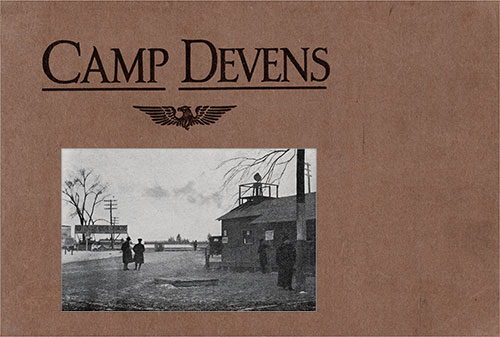
Front Cover with Photo Insert, Camp Devens: Described and Photographed, 1918. | GGA Image ID # 185c4bf98c
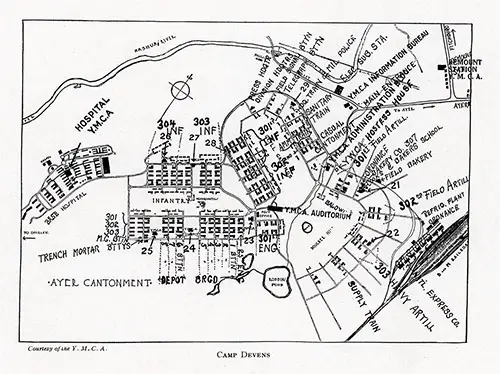
Map of Camp Devens. Courtesy of the YMCA. Camp Devens: Described and Photographed, 1918. | GGA Image ID # 185cf848a7
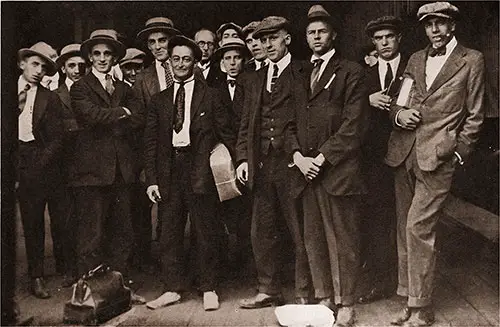
All Aboard for Ayer, Massachusetts. Soldiers Assemble at Train Station for the Trip to Camp Devens. Camp Devens: Described and Photographed, 1918. | GGA Image ID # 185d08a3c4
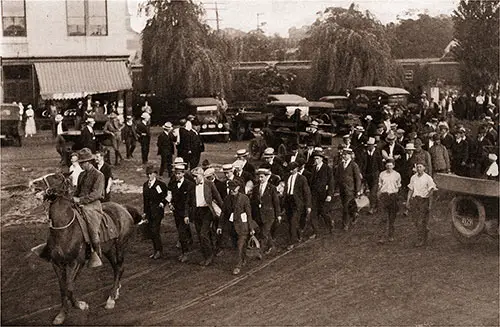
New Recruits Leaving the Train Station at Ayer, Massachusetts to March to Camp Devens. Camp Devens: Described and Photographed, 1918. | GGA Image ID # 185d5b363f
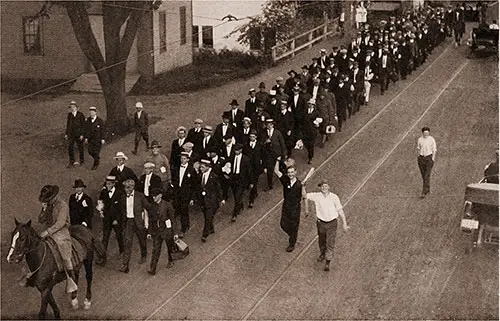
Next Stop -- Camp Devens. Recruits Continue to March Towards Their Destination, A Couple of them Look up to the Camera and Wave. Camp Devens: Described and Photographed, 1918. | GGA Image ID # 185d78a5f0
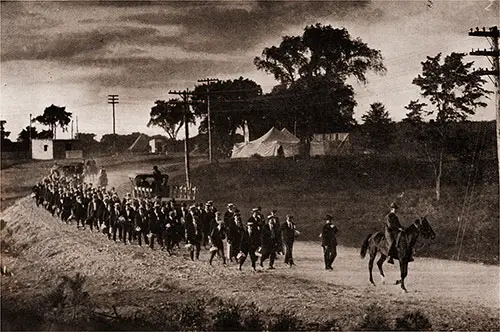
The Soldiers Who Marched From the Train Station at Ayer, Massachusetts Are About the Arrive at Their Destination. Camp Devens: Described and Photographed, 1918. | GGA Image ID # 185dcb650b
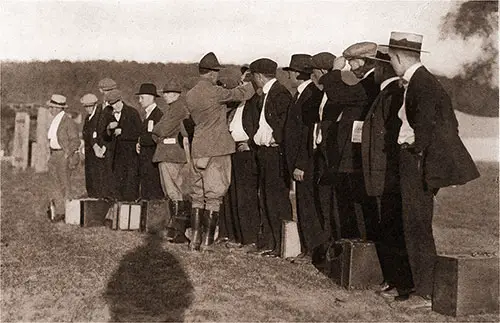
Let's See Your Teeth -- Non-Commissioned Officers Check Out the New Batch of Recruits. Camp Devens: Described and Photographed, 1918. | GGA Image ID # 185f0b50dc
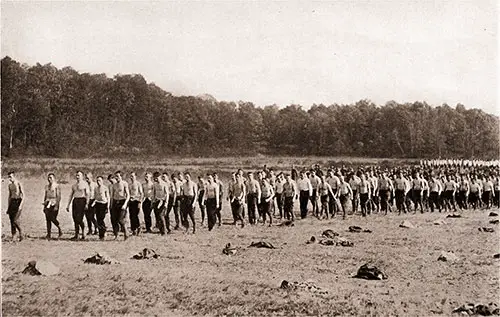
New Recruits at Camp Devens After the Setting-Up Drill. Camp Devens: Described and Photographed, 1918. | GGA Image ID # 185f0e9aa5
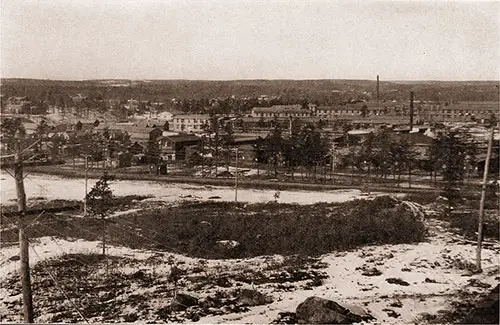
Looking North From Boulder Hill. In the Foreground, on the Further Side of the Road, Is the Commercial Center of the Camp. The Large Sign of Baldwins Restaurant Is Visible Through the Trees. In the Rear of Baldwin's Can Be Seen the Barracks of the 301st Light Field Artillery. Camp Devens: Described and Photographed, 1918. | GGA Image ID # 185f630b0c
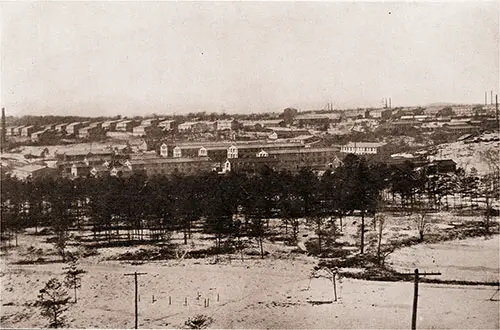
A Bird's-Eye View of Camp Devens Looking West From Boulder Hill. Camp Devens: Described and Photographed, 1918. | GGA Image ID # 185f83c79d
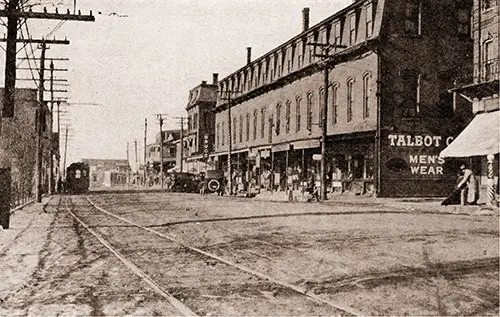
Main Street of Ayer, Massachusetts With a View of Broadway. Camp Devens: Described and Photographed, 1918. | GGA Image ID # 185fb8dc0c
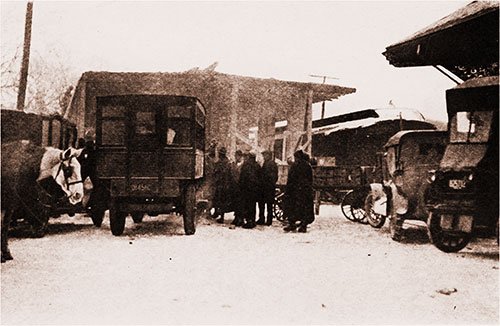
View of Automobile Row at the Training Station at Ayer, Where Jitney Drivers Stand Read to Take Soldiers to Camp -- for a Price. Camp Devens: Described and Photographed, 1918. | GGA Image ID # 185fcbcabc
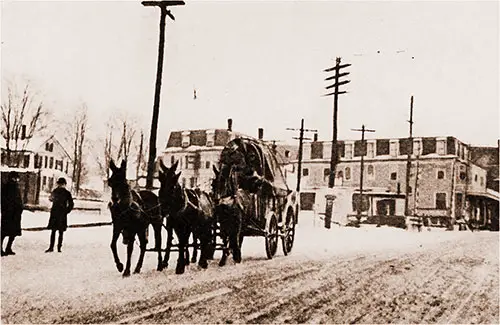
A Common Scene Is the Heavy, Rumbling Supply Wagons in the Streets of Ayer. Camp Devens: Described and Photographed, 1918. | GGA Image ID # 1860364dc4
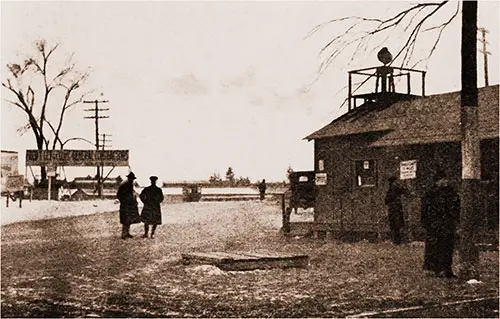
If the Visitor Arrives by Trolley at the Camp, He Leaves the Car at the Main Gate. Camp Devens: Described and Photographed, 1918. | GGA Image ID # 18604ba531
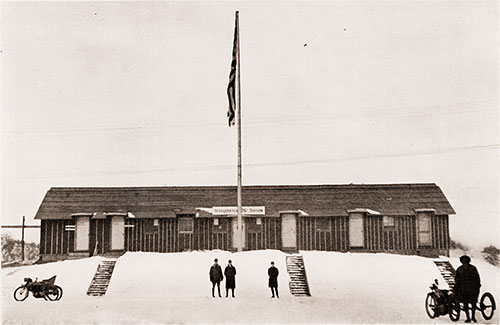
Divisional Headquarters Building of the 75th Division Is the Military Center of the Camp. Camp Devens: Described and Photographed, 1918. | GGA Image ID # 18605a9a70
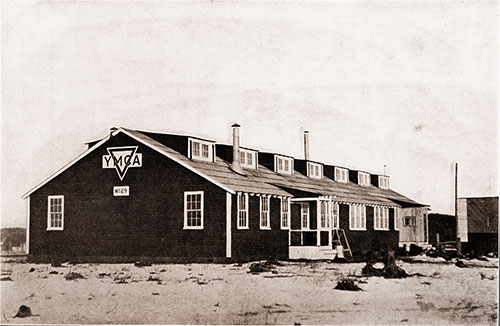
This Building Is One of Fourteen YMCA Huts at Camp Devens and Identified as YMCA # 29. Camp Devens: Described and Photographed, 1918. | GGA Image ID # 1860866b00
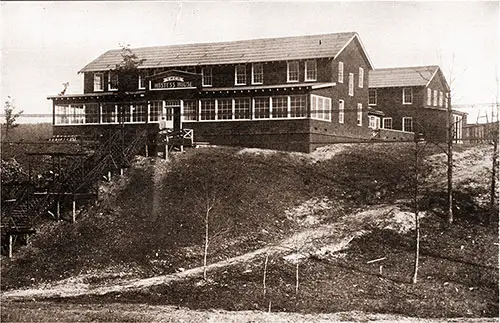
The YWCA Hostess House Stands on a High Bluff New the 301st Light Field Artillery, a Short Distance From the Road. Camp Devens: Described and Photographed, 1918. | GGA Image ID # 1860c58f10
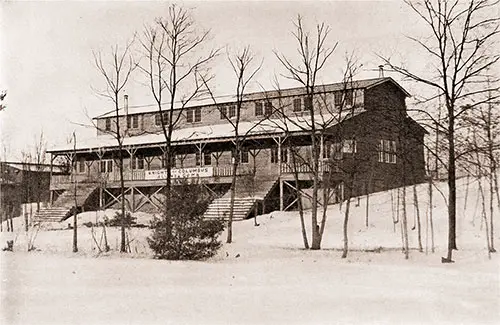
The Knights of Columbus Building -- K of C Hut # 3 at Camp Devens Where All Are Welcome. Camp Devens: Described and Photographed, 1918. | GGA Image ID # 1860c77a7b
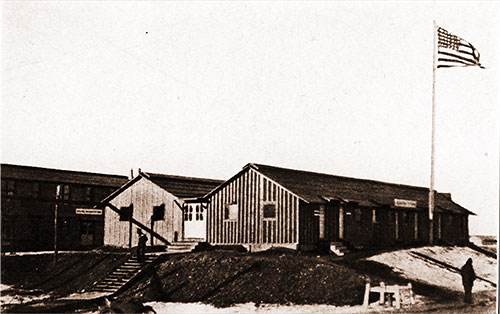
Divisional Headquarters Administrative Building from the Side Facing the 301st Infantry Barracks. Camp Devens: Described and Photographed, 1918. | GGA Image ID # 18ea3dc976
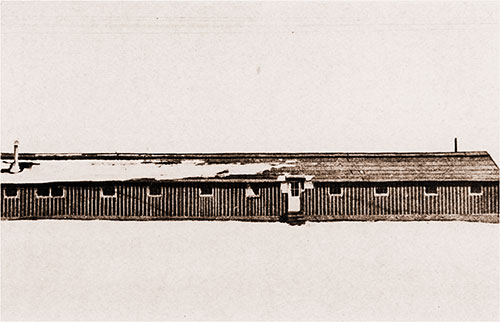
A Typical Officers' Quarters Building, Ordinarily in a Line Behind the Barracks of the Organization to Which Their Occupants are Assigned. Camp Devens: Described and Photographed, 1918. | GGA Image ID # 18ea8c162e
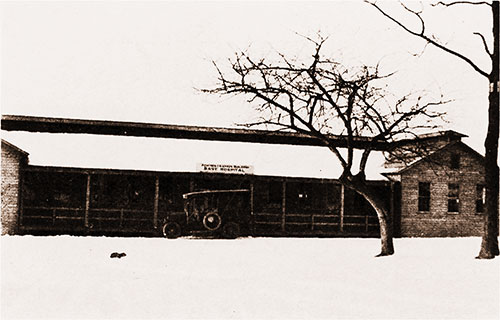
Base Hospital Headquarters Building, Located in the Rear of the Camp, Completely Isolated from the Other Organizations. Camp Devens: Described and Photographed, 1918. | GGA Image ID # 18ea9c3ca6
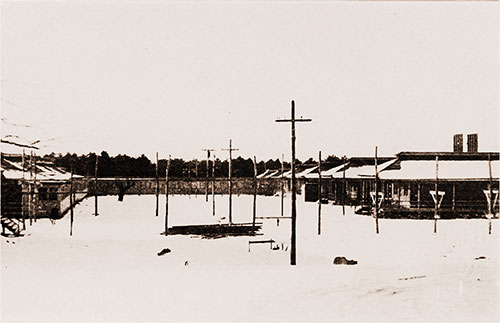
Base Hospital Barracks That Are Used as Housing for the Patients Averaging 800 Men per Day. Camp Devens: Described and Photographed, 1918. | GGA Image ID # 18eaa5d044
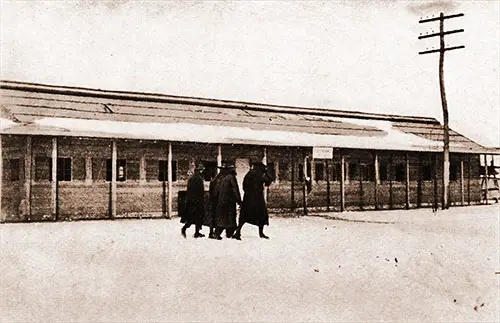
The Regimental Post Exchange Building Where Soldiers Can Purchase All Kinds of Food, Cigarettes, Stationery, Books, Postcards, Toilet Articles, etc. Camp Devens: Described and Photographed, 1918. | GGA Image ID # 18eb514e5f
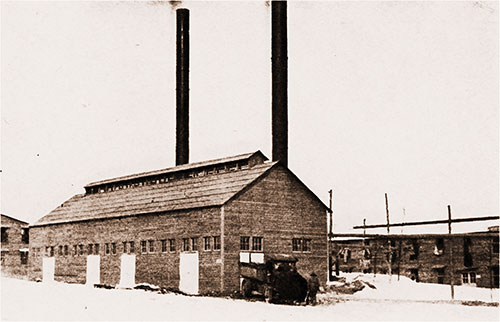
One of the Camp's Heating Plants. Camp Devens: Described and Photographed, 1918. | GGA Image ID # 18eb861c24
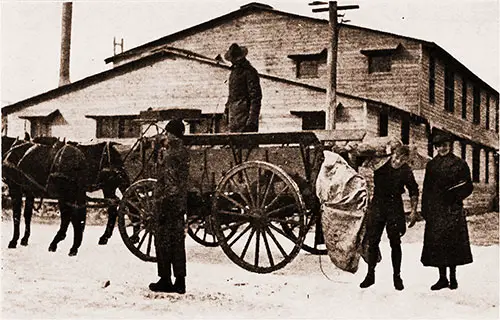
Supply Wagon Delivering Commodities Requisitioned by the Mess Sergeant Each Morning. Camp Devens: Described and Photographed, 1918. | GGA Image ID # 18eb8f1758
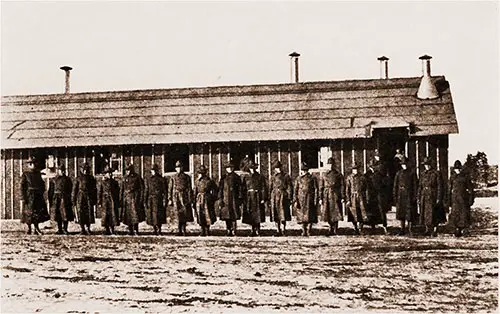
Different Companies Supply Guards on a Rotating Basis Shown Outside a Regimental Guard House Building. Camp Devens: Described and Photographed, 1918. | GGA Image ID # 18eba0049d
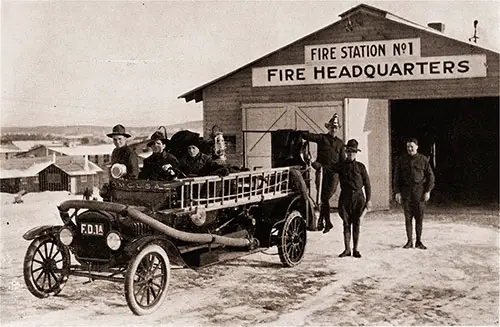
One of the Camp Fire Trucks in Front of Fire Station No. 1 Fire Headquarters. Camp Devens: Described and Photographed, 1918. | GGA Image ID # 18ebc7897f
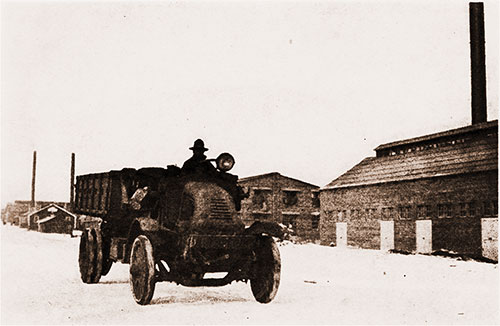
A Typical Army Truck, Belonging to the Quartermaster's Deparment. Camp Devens: Described and Photographed, 1918. | GGA Image ID # 18ebf50c72
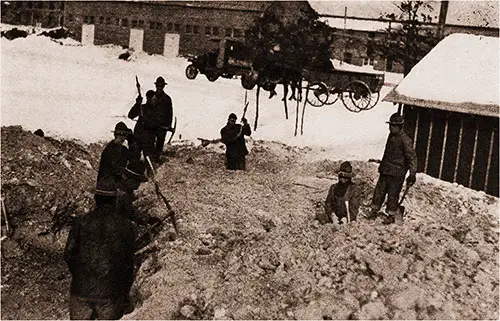
M Company, 302nd Infantry -- Men from Rockford and Quincy -- Building a Road. Camp Devens: Described and Photographed, 1918. | GGA Image ID # 18ec40f85a
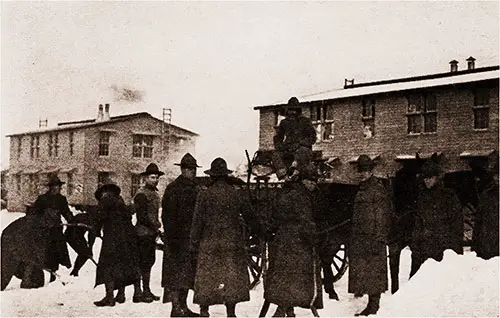
Group of Men From Headquarters Train Trying To Make the Roads Passable After a Snowstorm. Camp Devens: Described and Photographed, 1918. | GGA Image ID # 18ec46eb0c
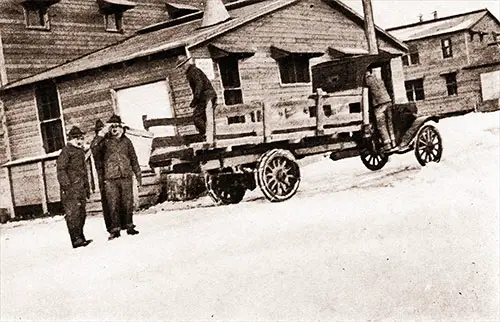
Ambulance Company Number 302 Loading Accumulated Garbage of the Day Into One of the Quartermaster's Trucks. Camp Devens: Described and Photographed, 1918. | GGA Image ID # 18ec595f3c
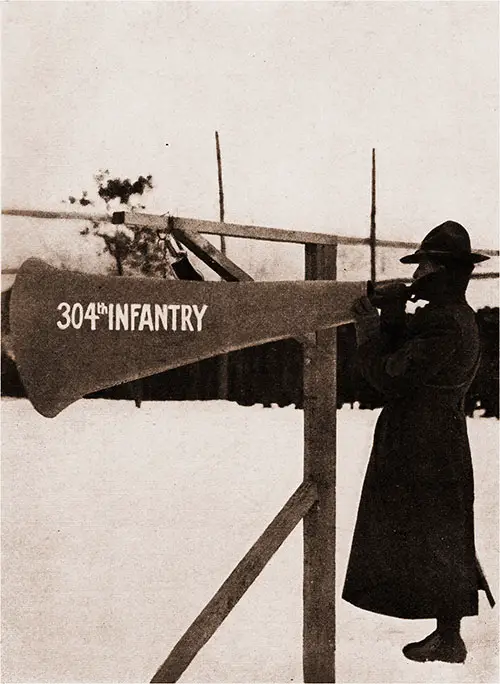
Bugler of the 304th Infantry Is Announcing To His Comrades Who Have Just Returned From Drill That Mess Is Waiting From Them. Camp Devens: Described and Photographed, 1918. | GGA Image ID # 18ec81ab5a
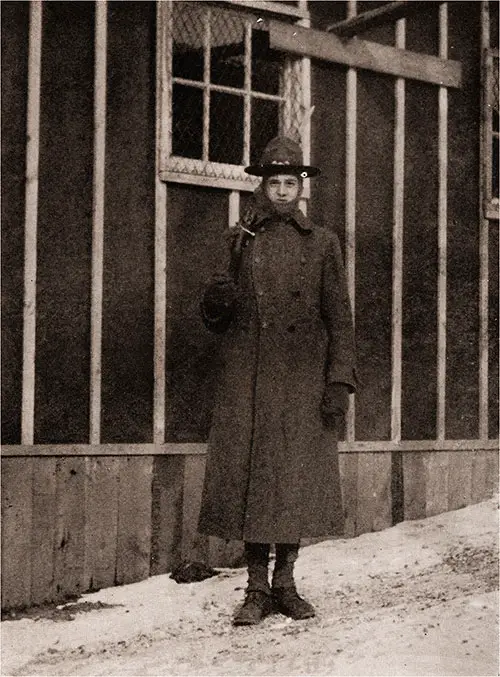
This Guard, With His Bayonet Fixed, Is Patrolling the Vicinity of a Battalion Headquarters of the 303rd Infantry. Camp Devens: Described and Photographed, 1918. | GGA Image ID # 18ec9d32c7
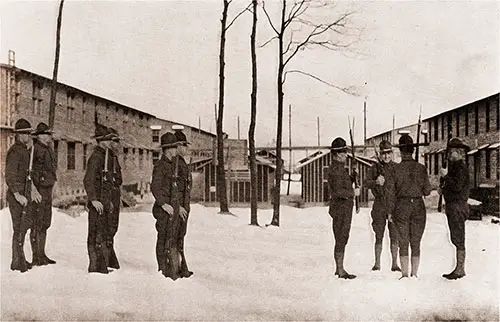
This Picture Shows the Relief of the Guard. in the Quadrangular Group, the Man on the Left Is the Old Guard at Post No. 6; He Has Been on Duty for Two Hours. Facing Him Is the Relief Who Will Take the Post for the Next Two Hours. the First One Is Explaining to His Relief the Limits of the Post, and Is Communicating Any Orders Which May Have Been Given Him. the Man With His Back Towards Us Is the Corporal of the Old Guard; Facing Him, With the Smile, Is the Corporal of the Relief. the Six Men Are Partly of the Old Guard and Partly of the Relief. When the Column Moves on, the Man Who Has Been Relieved Will Fall in at the Rear and Return to the Guard-House for Four Hours of Rest. Camp Devens: Described and Photographed, 1918. | GGA Image ID # 18edcff7b1
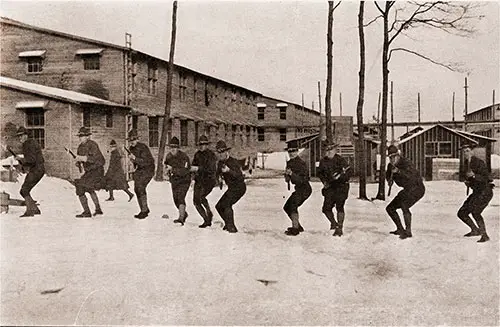
Men of the 13th Company, Depot Brigade Taking Bayonet Practice. Before the Men Leave for France, Every One of Them Will Know How To Defend Himself From Another Bayonet, How To Conduct an Offensive, and How To Combine Skillfully the Two Movements. Camp Devens: Described and Photographed, 1918. | GGA Image ID # 18ee0ce1ed
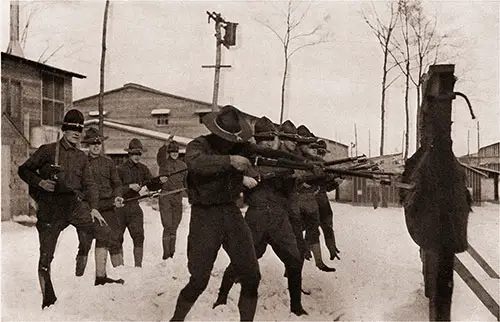
The Bayonet Fighters Shown Are Men of the 13th Company, Depot Brigade, Receiving Instruction in Thrusting From Lt. Russel Codman of the 4th Battalion. Camp Devens: Described and Photographed, 1918. | GGA Image ID # 18ee16b3d0
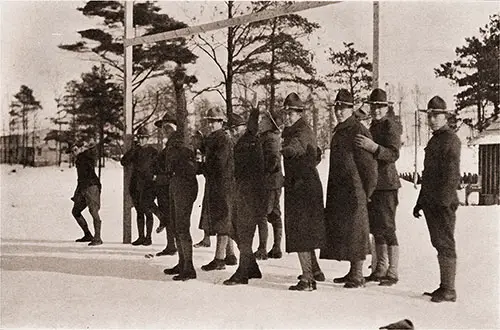
Group of Non-Commissioned Officers From the 7th Battalion, Depot Brigade, Learning the Rudiments in Advance of the Privates So That They Will Be Able To Instruct Their Charges When the Time Comes. Camp Devens: Described and Photographed, 1918. | GGA Image ID # 18ee3cedaa
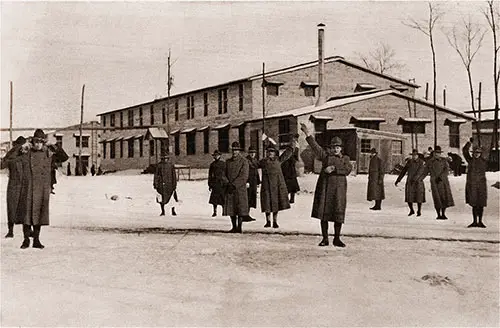
Semaphoring Signaling Training. Ordinarily, Flags Are Used, as They Are More Easily Seen, but in This Picture Where the Training Is Taking Place, They Are Not Necessary, and Only Two Men Seem To Be Equipped With Them. the Semaphore Code Is Very Simple and the Letters Follow Certain Movements of the Arms in Logical Sequence. the Man in Front Is Signaling the Letter O. of the Three Men on the Right Whose Arms Are Raised, the First Is Giving the Letter J, and Those Behind Him Are Both Signaling the Letter a. the Signalers Are Members of the 14th and 15th Companies of the Depot Brigade. Camp Devens: Described and Photographed, 1918. | GGA Image ID # 18ee533953
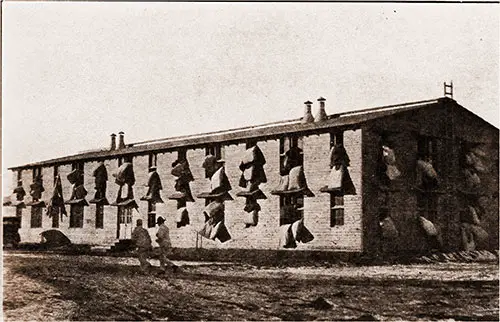
Blankets and Mattresses Are Suspended Out the Barrack Windows of the 302nd Light Artillery During Morning Drill. The Sanitary Officer of Camp Devens Has Decreed That as a Health Precaution All Blankets and Mattresses Shall Be Suspended During the Hours of Morning Drill From the Windows of the Barracks, and That Every Window in the Building Shall Be Open. That Is the Reason for the Rather Astounding Display of Sleeping Accoutrements in This Barracks of the 302d Light Artillery. Camp Devens: Described and Photographed, 1918. | GGA Image ID # 18eea5377f
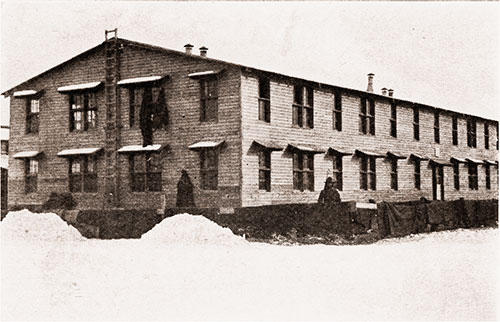
Quarantined Barracks of a Caisson Company of the Ammunition Train. The Medical Authorities Have Also Taken Strict Precautions to Prevent the Spread of Any Epidemic Among the Draft Men. the Few and Scattered Cases of Measles Have Resulted in the Wholesale Quarantine of the Companies to Which the Sick Men Belonged. This Picture Shows the Quarantined Barracks of a Caisson Company of the Ammunition Train. A Promenade Has Been Fenced in for the Guard; He Will Allow No One to Come Within the Outside Fence, and the Patients Are Restricted to That Area Enclosed by the Inside Barrier. Camp Devens: Described and Photographed, 1918. | GGA Image ID # 18eede4c6c
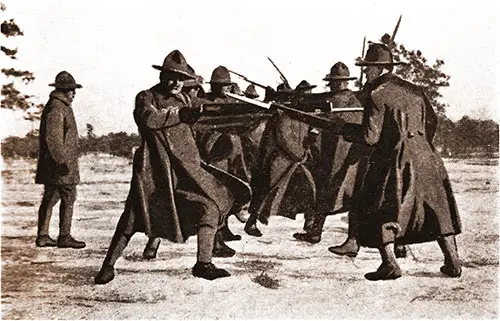
First Lieutenant H. D. White Instructing His Men From H Company of the 302d Infantry in Bayonet Drill. In Order to Illustrate the Many Varieties of Offensive and Defensive Positions, the Lieutenant Has Ordered Each Pair to Assume a Different Pose. The Men on the End Are Executing the Preliminary Movements, but in the Center We Can See a Man Who Has Come to Close Quarters With His Adversary and Is, So to Speak, “After Him Tooth and Nail.” This Platoon Is From H Company of the 302d Infantry, and the Combatants Formerly Lived on Cape Cod. Camp Devens: Described and Photographed, 1918. | GGA Image ID # 18eee26d8b
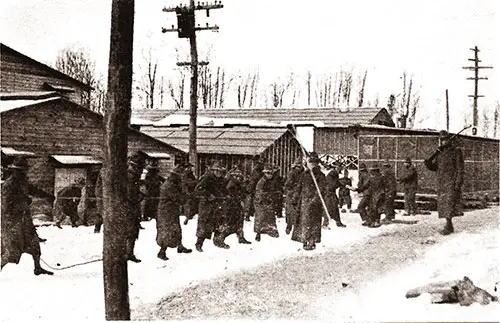
Men From the 304th Infantry Moving a Building Formerly Used as Sleeping Quarters for Civilian Workmen. These Men From the 304th Infantry Realize That a Soldier Is Expected to Do Every Kind of Work on the Calendar. a Building Which Was Formerly Used as Sleeping Quarters for the Civilian Workmen Was Needed Near the Regimental Headquarters for a Motor-Cycle Garage. Accordingly, a Detail Was Called to Transfer It, and Now the Moving Is in Full Progress. They Have About Three Blocks Farther to Go, but Judging From the Happy Expressions on Their Faces, the Distance Does Not Seem to Be of Much Concern. Camp Devens: Described and Photographed, 1918. | GGA Image ID # 18ef10b7c7
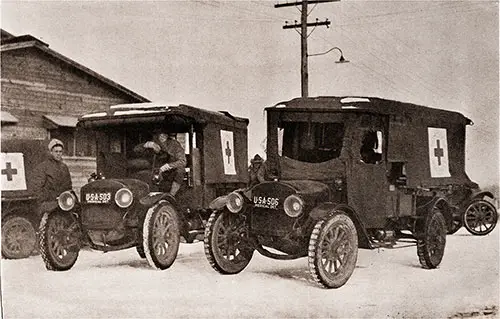
Three of the Ambulances Waiting Near One of the Regimental Infirmaries for Patients to Take to the Base Hospital. The Medical Corps at Camp Devens Is Under the Direction of Lieutenant-Colonel Powell, the Divisional Surgeon, Who Has Under Him 230 Officers and 1,100 Men. Besides the Base Hospital There Are Twenty-Six Infirmaries, Attached, for the Most Part, to the Regimental Units. Each of These Smaller Hospitals Has a Staff of Officers and Trained Men to Take Care of the Trivial Cases or to Administer First Aid Upon Event of an Emergency. Camp Devens: Described and Photographed, 1918. | GGA Image ID # 18ef57b361
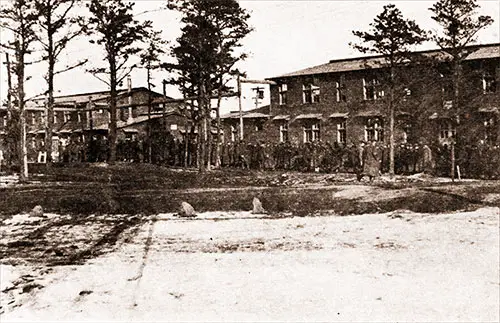
Captain Gallaudet of Waterbury Has Just Ordered His Organization, Battery F, 303rd Heavy Field Artillery to Fall in for Fatigue Duty. It Is Early Afternoon, and the Entire Regiment Is About to Pick up the Grounds and Do Odd Jobs in the Vicinity. A Quarter-Mile Away, There Is a Huge Supply of Wood, Scattered Promiscuously Over the Landscape; These Boys From the North Will Spend the Afternoon Gathering and Placing It in Piles for the Trucks to Distribute. Camp Devens: Described and Photographed, 1918. | GGA Image ID # 18efdb7f63
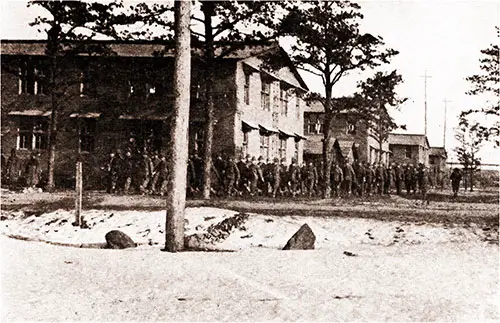
Battery D of the 303rd Heavy Field Artillery Rounds the Corner Wearing Blue Overalls to Keep Their Uniforms From Getting Dirty. A Road Not Far Away Must Be Opened Before Night and the Soldiers Have Donned Blue Overalls to Keep Their Uniforms From Getting Dirty. They Surely Present a Strange Appearance, With Their Campaign Hats and the Blue, Loose-Fitting Clothes, in Place of the Regulation Khaki. Camp Devens: Described and Photographed, 1918. | GGA Image ID # 18f018cd24
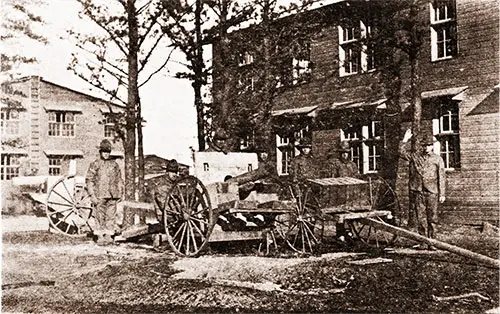
Lt. Julian L. Lanthrop Drills a Squad from Battery E, 303rd Heavy Field Artillery. Lieutenant Julian L. Lathrop, the Former Harvard Athlete, Who Has Been in the Ambulance Service at the Western Front, Is Drilling a Squad From Battery E. in the Absence of Horses and Artillery, They Use Wooden Imitations and Themselves Drag the “Big Guns” Around. They Are Now Ready to Fire; There Is a Goodly Supply of Theoretical Ammunition in the Wooden Caisson at the Right of the Gun, and the Sergeant Is About to Give the Signal Which Will (Also Theoretically) Cause a Shell to Disturb the Peaceful Quiet of the Town of Clinton, Ten Miles Away. Camp Devens: Described and Photographed, 1918. | GGA Image ID # 18f02be82f
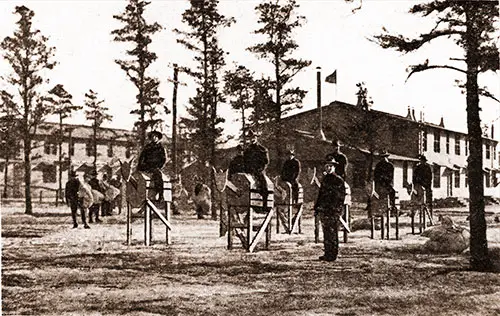
Practice Makes Perfect in the Gentle Art of Equestrianism. On the “Camouflaged” Horses the Same Squad Is Learning the Fine Points of Equestrianism. When the Genuine Articles Arrive, All That Will Be Necessary Will Be to Get on Good Terms With the Animals. Camp Devens: Described and Photographed, 1918. | GGA Image ID # 18f0ab2f99
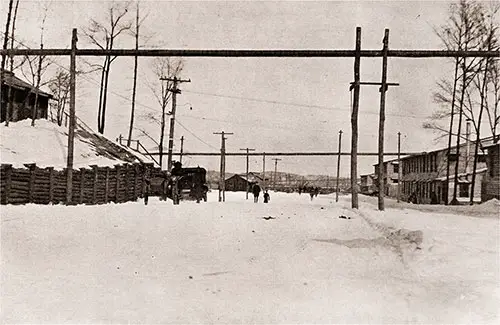
Main Street of the Depot Brigade Barracks. The Headquarters in on the Knoll at the Left, and the Battalion Streets, in Lines of Barracks, Run Perpendicularly to the Right From This Thoroughfare. Camp Devens: Described and Photographed, 1918. | GGA Image ID # 18f0eee076
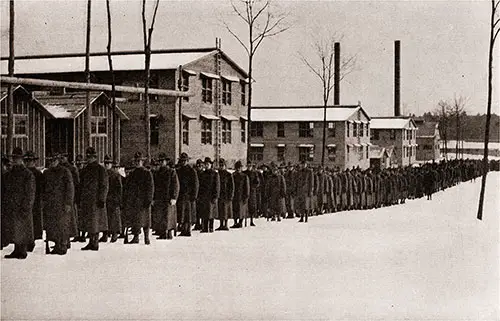
A Depot Brigade Battalion, Comprising in This Case About 500 Men, and Made up of Four Skeletonized Companies. Camp Devens: Described and Photographed, 1918. | GGA Image ID # 18f1ad3c48
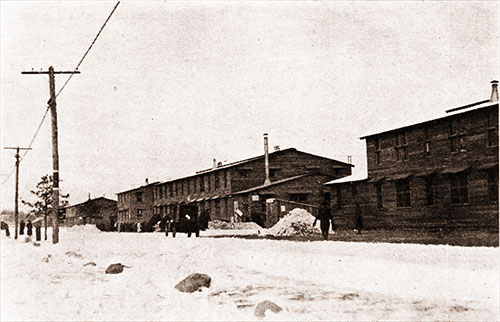
The Main Street and Some of the Barracks of the Headquarters Train. Camp Devens: Described and Photographed, 1918. | GGA Image ID # 18f24326be
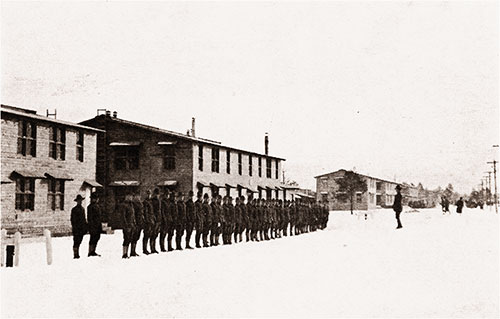
The 204th Ambulance Company at Right Dress. This Unit Is a Part of the Medical Corps, but Its Barracks Are Adjacent to Those of the Train. These Boys Are Mainly From Worcester and Springfield. Camp Devens: Described and Photographed, 1918. | GGA Image ID # 18f279de3f
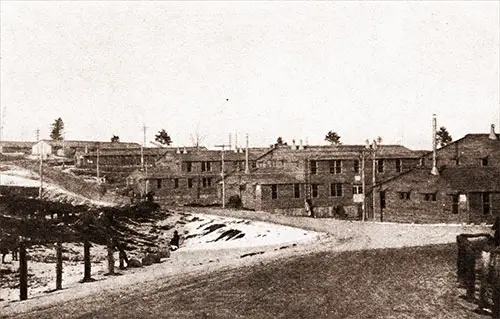
A View of the Barracks of the 301st Signal Battalion. The First Three Belong to Companies A, B and C, Respectively; The Building Beyond, Which Resembles an Officers’ Quarters, Is That of the Headquarters Detachment. Camp Devens: Described and Photographed, 1918. | GGA Image ID # 18f28b5369
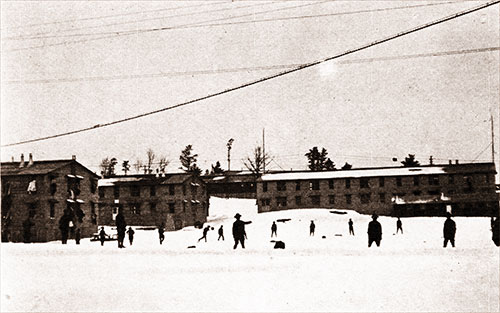
Another View of the Signal Corps, Showing the Drill Field. the Building in the Background, Upon Which the Antennae of the Wireless Are Seen, Is for the Overflow From the Three Other Buildings. the Wireless, Which Is Now in the Officers’ Quarters, Will Also Be Moved Into the New Structure. Camp Devens: Described and Photographed, 1918. | GGA Image ID # 18f3150e5c
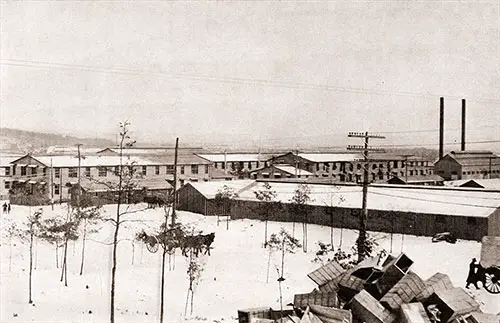
The 301st Infantry Is Situated a Hundred Yards to the South of the Divisional Headquarters. The Commanding Officer Is Colonel Frank Tompkins. This Picture Shows the Barracks of the Regiment, Taken From the Rear. Camp Devens: Described and Photographed, 1918. | GGA Image ID # 18f31b49ac
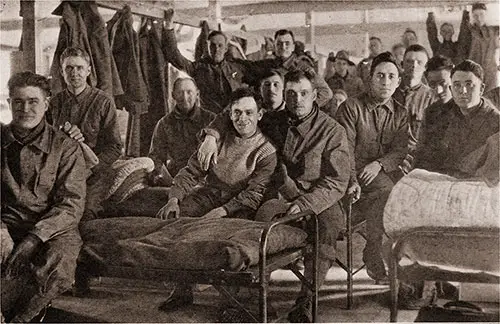
The Quarters of the Supply Company, 301st Infantry. The Boys in This Barracks Are of the Supply Company of the 301st. When the Picture Was Taken, They Had Just Finished “Tidying up” the Big Room for Inspection. Camp Devens: Described and Photographed, 1918. | GGA Image ID # 18f31e6dd3
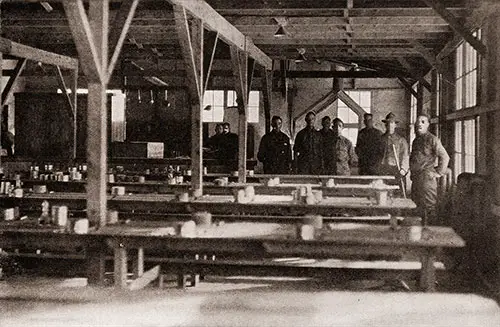
The Mess-Hall Shown Here Is That of a Company of the 303d Infantry. The Kitchen Police, One of Whom Has a Mop in His Hand, Are in the Foreground; The Cooks Can Be Seen Behind the Sideboard. Camp Devens: Described and Photographed, 1918. | GGA Image ID # 18f35f788d
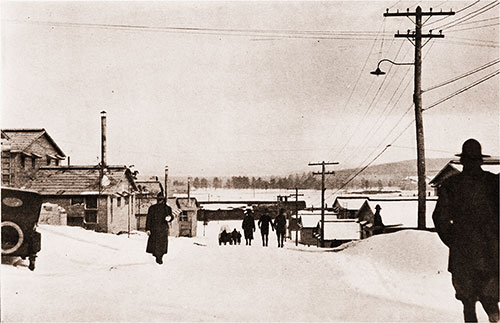
The Street in the Picture Runs Through the Barracks of the 302d Infantry, and Connects the Regimental Street in Front With the Highway in the Rear. The Latter Encircles the Barracks of the 301st and the 302d. Looking Down the Hill, One Can See the Great Parade Ground, or Drill Field, Which These Two Regiments Overlook. Camp Devens: Described and Photographed, 1918. | GGA Image ID # 18f41d4bb2
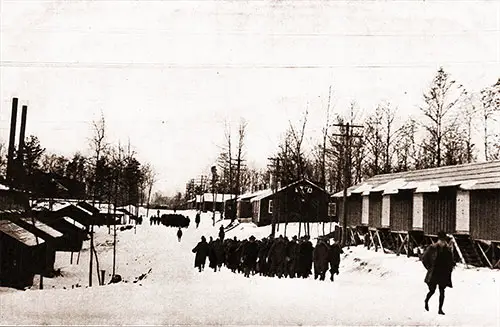
A Detail from the 302nd Infantry. At seven-thirty this morning a detail from the 302d Infantry was formed, and was ordered to don overalls and take picks and shovels, instead of rifles, for the morning drill. The unit had representatives of nearly every company in the regiment. It is Saturday noon and now they are returning to their barracks. For most of them, the week’s work is over, and a day and a half of rest is in prospect. Camp Devens: Described and Photographed, 1918. | GGA Image ID # 18f44e532b
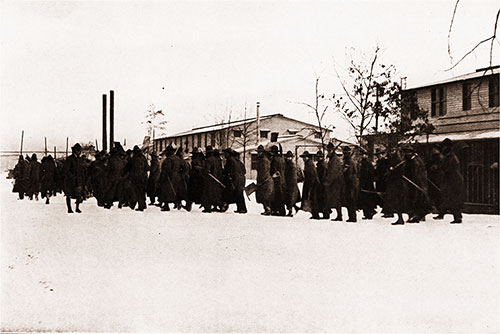
A Company From the 303d Infantry Returning to the Barracks for Mess, After Several Hours of Strenuous "Fatigue Duty." the Regiment Is Commanded by Colonel J. F. Preston. Camp Devens: Described and Photographed, 1918. | GGA Image ID # 18f46f33ba
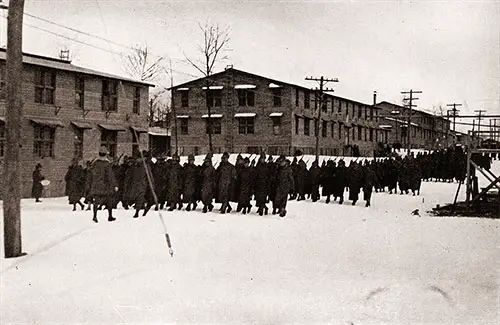
A Column of Platoons from the 304th Infantry. It Is Hard to Realize That Many Members of This Column of Platoons, Which Is Now Marching Like a Veteran Body, Were Working at Machines Three Months Before and Had Not the Slightest Idea of Military Regulations. Then Some of Them Could Not Understand Spoken English, and Their Only Idea of Discipline Was That of the Factory. Now They Are Living Under Better Conditions Than Some of Them Enjoyed in the Factory Towns From Which They Came, Keeping Regular Hours, Taking Continuous Exercise and Eating Good, Wholesome Food. Is It Any Wonder That They Make Such a Good Showing? Camp Devens: Described and Photographed, 1918. | GGA Image ID # 18f4bab0fe
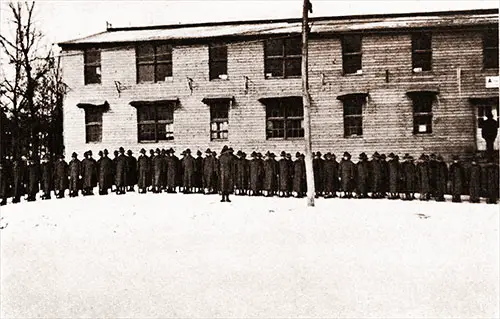
“A” Company of the 304th Infantry Has Just Formed and the Captain Is Explaining the Procedure That Is to Follow. At the Same Time the Other Companies Are Likewise Forming and Receiving the Same Instructions. the Captain Then Marches the Company to the Place Where the Battalion Is to Assemble. He Reports to the Major, Who Takes Charge of the Battalion, and Marches It to the Designated Place on the Parade Ground. Camp Devens: Described and Photographed, 1918. | GGA Image ID # 18f4c41d24
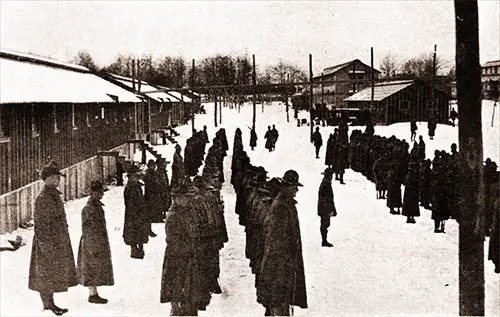
The First Battalion, 304th Infantry, Has Taken Its Place, and the Line in the Rear Is Standing at Attention. Camp Devens: Described and Photographed, 1918. | GGA Image ID # 18f510d753
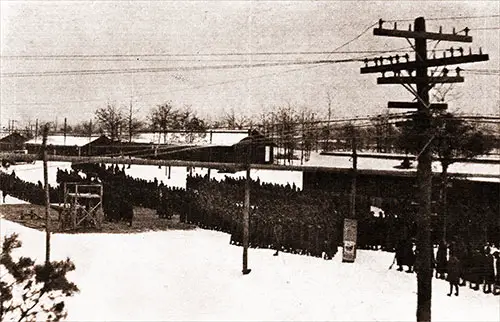
The Entire Regiment, 304th Infantry, Is Now in Position Before the Reviewing Stand. An Officer With a Megaphone Is Explaining Certain Details Which Must Be Learned Before the Next Formation. Camp Devens: Described and Photographed, 1918. | GGA Image ID # 18f5198500
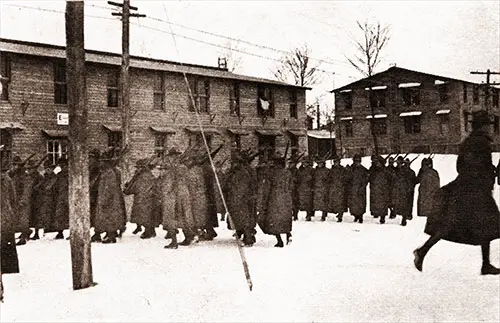
The Formality Being Over, the Battalions of the 304th Infantry Are Returning to Their Barracks in Column of Platoons, That Is to Say, Several Squads Abreast. the Order Comes “Platoon Right by Squads.” The Platoon on the Left Is Changing Its Formation and Instead of Marching in Platoon Line, Like the Second Unit in the Picture, It Is Forming a Column of Squads, — One Squad Behind the Other, the Usual Marching Formation. In This Formation, the Captains Take Their Men to Their Barracks. Camp Devens: Described and Photographed, 1918. | GGA Image ID # 18f54be032
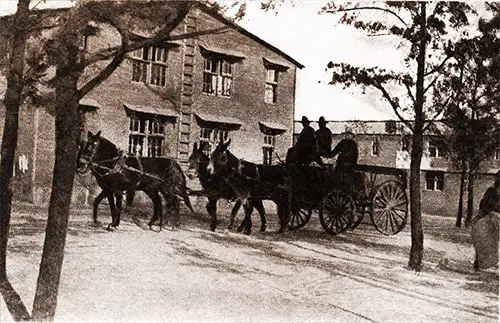
The Supply Team Once More We Have One of the Mule Teams; This One Is an Adjunct to the Supply Company of the 303rd Heavy Field Artillery the Transportation and Distribution of Company Supplies Comes Within the Province of the Supply Company, a Unit Which Is Attached to Each Regiment. the Men Usually Selected for This Organization Are Those Who Have Had Previous Experience in Taking Care of Horses and Mules, or in Driving Carts. In the Regular Army, the Supply Men Have the Longest Working Hours of Any Enlisted Men in the Service. Directly After Breakfast, They Harness Their Teams and Drive Away; They Do Not Appear Again at Their Quarters Until Supper Time. Camp Devens: Described and Photographed, 1918. | GGA Image ID # 18f5a788ae
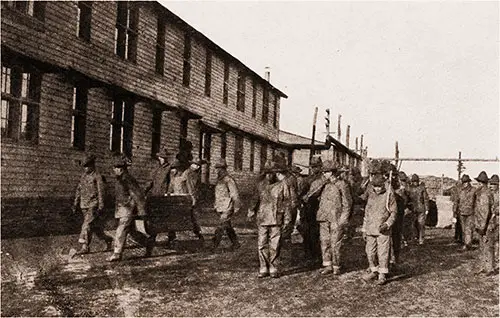
Policing the Grounds. The Word “Police,” Taken as a Verb, Means, in Military Parlance, to “Clean up.” The “Policing” of a Mess Hall Signifies the Sweeping of the Floor and Washing of the Tables. the “Policing” of the Camp Grounds Denotes the Cleaning up of All Papers and Rubbish in the Vicinity. Two Men Carry a Box or a Sack for the Refuse; The Rest Pick up Every Scrap Which Might Arouse the Wrath of the Vigilant Inspector or Sanitary Officer. Here We Have a Group of Men From the 302d Field Artillery, Putting Their Grounds in Good Order for an Expected Inspection by the Colonel. Camp Devens: Described and Photographed, 1918. | GGA Image ID # 18f5cfb651
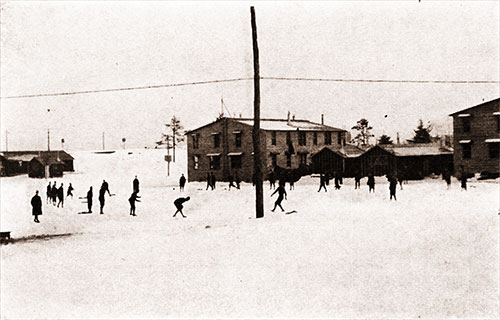
Throwing the Medicine Ball. Outdoor Games Are Often Substituted for the Setting-up Exercises. This Circle of Men From the Signal Corps Is Engaged in Throwing About a Heavy Medicine Ball. the Physical Training of the Camp Is Superintended by R. F. Nelligan, a Civilian Instructor, Who Was Formerly the Professor of Hygiene and Physical Exercise at Amherst College. Mr. Nelligan Offered His Services to the War Department and Was Sent to Ayer in November. Camp Devens: Described and Photographed, 1918. | GGA Image ID # 18f634bbdb
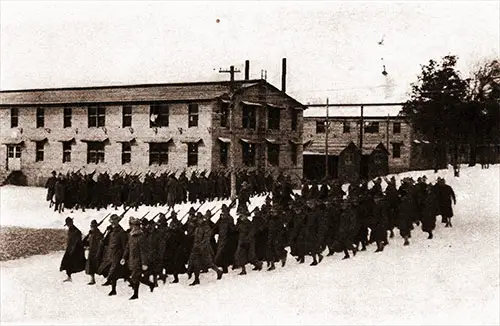
Marching. This Picture Shows the First Battalion of the 304th Infantry, Which Is About to March to the Drill Field for Practice in Battalion Formations and Movements. Camp Devens: Described and Photographed, 1918. | GGA Image ID # 18f6358227
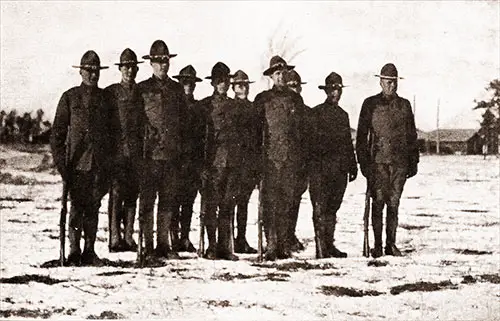
“The Prize Squad.” When Members of Companies I and K, 302d Infantry, Came Down With the Measles, the Other Members of the Unit Were Placed Under Strict Quarantine. in Order to Prevent Loss of Valuable Time While Waiting for the Quarantine to Be Lifted, the Officers Took Groups to Isolated Parts of the Camp and Conducted the Drills. the Picture Shows a Group of Noncommissioned Officers of the Two Companies Indulging in a Quiet, Private Drill, “Far From the Madding Crowd.” the Lieutenant in Charge Informed Me That They Were the “Prize Squad of the Camp.” Camp Devens: Described and Photographed, 1918. | GGA Image ID # 18f652c67f
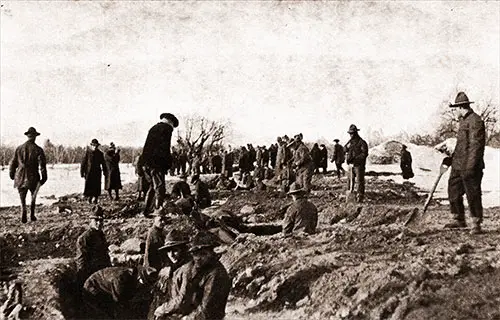
At the Trenches. Men From the 303d Infantry Are Seen Digging a First-Line Trench. While One Shift of Men Is Working, the Rest Receive Explanations and Instructions. Camp Devens: Described and Photographed, 1918. | GGA Image ID # 18f683a858
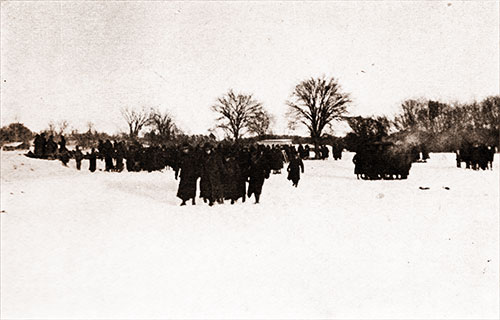
The 301st at the Range This Picture Gives a Good Idea of the Appearance of the Rifle Range in the Afternoon. the Crowd of Men Who Are Waiting Behind the Firing Line Are From the 301st Infantry. They Are on the Hundred Yard Range, and the Men Are Shooting From a Standing Position. Camp Devens: Described and Photographed, 1918. | GGA Image ID # 18f71b5d6b
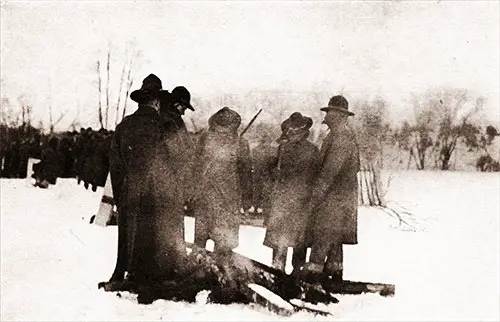
Keeping Warm. When the Temperature Drops at the Trenches, the Men Gather Brush and Old Boards and Do Their Best to Keep Warm. The Large Number of Men Around the Fire Is Good Proof of Its Popularity at the Present Chilly Moment. When the Cold Becomes Intense, the Captains Send for Hot Coffee From the Company Kitchens. This Is Brought to the Trenches in Huge Boilers by the Supply Wagons. Such Acts of Forethought and Kindness to the Men Are Indicative of the Spirit of the Officers at Ayer; They Make Every Effort Not Only to Train Their Men, but, at the Same Time, to Keep Them Comfortable and Contented. Camp Devens: Described and Photographed, 1918. | GGA Image ID # 18f727b93b
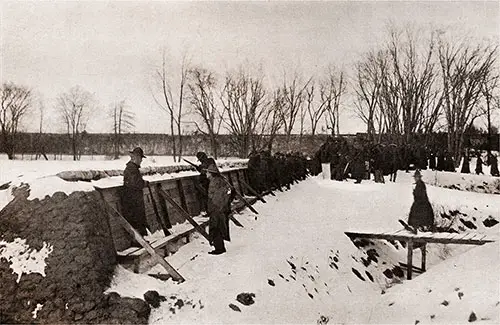
The Men in the Picture, Belonging to the 304th Infantry, Are Firing From a Trench Which Is an Exact Copy of a Firing Trench on the Western Front. When Standing on the Floor of the Trench, the Soldiers Are Not in Range of the Enemy's Rifle Fire; The Firing Step Enables Them to Shoot Over the Top of the Parapet. the Scores of the Men Have Been Most Gratifying; At the 100-Yard Range, Some Organizations of the 304th Have Had an Average of Forty Out of a Possible Fifty Points. Camp Devens: Described and Photographed, 1918. GGA Image ID # 18f740d360
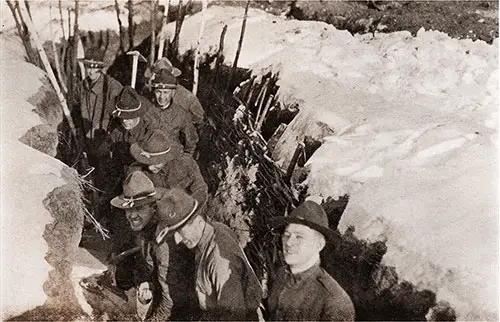
The Picture Shows Some Men of the 303d Infantry in a Communication Trench. The Wooden Frame-Work Constitutes, in Military Parlance, a Revetment of Fascines, Which Has Been Constructed to Obviate Any Possibility of a Cave-In. Camp Devens: Described and Photographed, 1918. | GGA Image ID # 18f7528bae
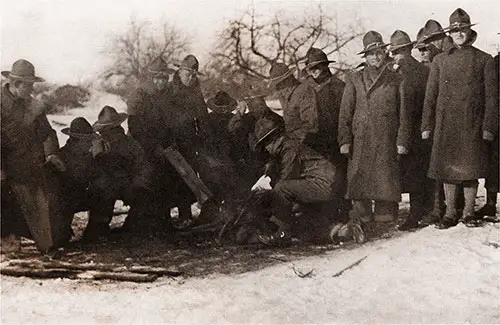
The Authorities Have Had One Great Object — to Keep the Men in Their Own Districts Until They Leave for France. According to This Plan, the Men Have an Opportunity to Go Home Frequently, and Their Friends and Relatives Are Enabled to Visit the Cantonments. and by This Method, the People Can See Just What Progress the Men Are Making; The Mother Can Realize the Great Care That Is Taken of Her Boy, and the Benefit Which He Receives Day by Day From the Training. Camp Devens: Described and Photographed, 1918. | GGA Image ID # 18f77c667e
Roger Batchelder, Camp Devens: Described and Photographed, Boston: Small, Maynard & Company, 1918. Foreword by Major Roger Merrill with photographs taken by the author under the official authorization of the Committee on Public Information and the War Department and the authorities' endorsement at Camp Devens.
